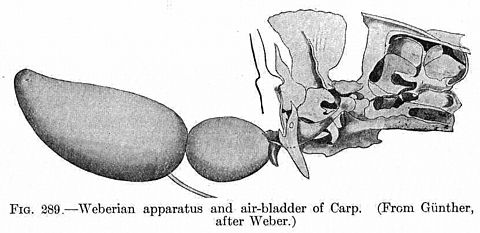Weber's apparatus

The Weber's apparatus is a part of the hearing organ in the Ostariophysi ; This group of bony fish includes the carp-like (Cypriniformes), the tetra-like (Characiformes), the catfish-like (Siluriformes) and the New World knife fish (Gymnotiformes). It was named after the German physiologist and anatomist Ernst Heinrich Weber .
The Weber apparatus connects the swim bladder of these fish with their labyrinth and consists of several small bones that can be traced back to parts of the spine and tendon ossifications. Similar to the three ossicles of mammals , Weber's apparatus is used to transmit sound waves from the swim bladder to the inner ear . While in mammals the eardrum and additionally the skull bones serve as a soundboard , in fish the swim bladder - if available - takes on this task of sound perception.
Especially low-frequency sound impressions can be perceived by fish through the lateral line organ ; for higher frequencies (which allow directional hearing better), however, certain otoliths (see Umberfische ) or the Weber apparatus are responsible.
Fish that occur in calm waters are generally considered to have better hearing than those that live in mountain streams or the surf zone of the sea. Carp , tetra and catfish are considered to be very well-hearing fish ; Trout on the other hand (which do not belong to the Ostariophysi and therefore do not have Weber's apparatus) have poor hearing.
literature
- Ernst Heinrich Weber : De aure et auditu hominis et animalium. Published by Gerhard Fleischer, Leipzig 1820.
- Friedrich Ladich: Acoustic communication in fish: sound formation, hearing and the influence of noise. In: Meeting reports of the Society of Friends of Natural Sciences in Berlin. (NF) Volume 49, 2013, pp. 83–94, full text (PDF)